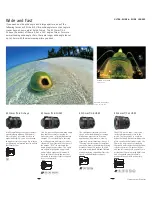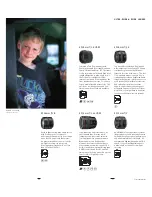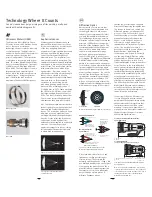
General Purpose Filters for Black and
White or Color Film
Sky (1A), Haze (UV-1), ND (03 • 0.6)
• 52mm • 58mm • 72mm
Conversion Filters for Color Film
80A, 80B, 85, 85B, FCB, FCD
• 52mm • 58mm • 72mm
General Purpose Filters for Black
and White Film
Yellow 2, Green 11, Orange 15, Red 25A
• 52mm • 58mm • 72mm
Softmat Filters
Softmat filters mildly soften the focus for
flattering portraits and dreamy landscapes.
These filters utilize the effect of diffraction which
occurs between light passing through the
transparent part and light passing through the
coated part. Use Softmat No. 1 filter for a gentle
softfocus effect, and Softmat No. 2 for a
stronger effect.
No.1, No.2
• 52mm • 58mm
Warming Filters for Color Film
81A, 81B
• 52mm • 58mm • 72mm
Circular Polarizing Filters PL-C
Polarizing filter enhances picture quality by
blocking harmful reflected light. Use it to
reduce polarized light reflections from glass
and water surfaces or to improve color satura-
tion. Simple to use, circular polarizing filters
(such as Canon’s PL-C) polarize light circularly,
rather than linearly, so it does not interfere
with autofocus or TTL light metering.
• 52mm • 58mm • 67mm • 72mm • 77mm
(Type II)
Loupe 8x & 4x
The Canon Loupe 4x is a high-performance
magnifier for viewing the entire picture area
(24 x 36mm) of a 35mm-format slide or nega-
tive. With three lens elements in three groups,
chromatic aberration and distortion are effec-
tively corrected to give crystal-clear images.
Eye fatigue is not a problem even after pro-
longed use. Loupe 8x is another magnifier for
viewing the entire picture area, but with spe-
cial emphasis on a 24mm-diameter area at the
center. The four lens elements in four groups
attain high performance and a high magnifica-
tion. All elements have Super Spectra Coating
to make image viewing clear enough for you to
effectively check the quality of photos taken
with EF lenses. These two loupes can make
your evaluation of photos more accurate.
Focus Preset
With the focus preset feature, you can
set the desired focusing distance in
memory and later instantly focus the lens
at that distance. Normal picture-taking
and focusing are possible even while
focus preset has been set. At a soccer
game, for example, you can preset the
focus for the goal. You can focus normally
while the player approaches the goal,
then when the ball is shot into the goal,
you can obtain instant focus.
Fluorite (CaF2) and UD-Glass
The refraction of light differs depending
on the wavelength. The point of focus
therefore differs depending on the
different wavelengths or colors. When
the different wavelengths are focused
at different points, the colors look
smeared. This is called chromatic
aberration. The longer the focal length,
the more pronounced chromatic aberration
becomes. Usually, an achromatic
element is used in a lens to correct
chromatic aberration. However, normal
optical glass can only be corrected for
two primary spectral colors. An exception
to this limitation is Fluorite, an ideal
material. Fluorite, which is crystalline,
has abnormally low refraction and low
dispersion characteristics, which optical
glass cannot achieve. It also has
anomalous dispersion from the green
to blue wavelengths. Canon developed
production technologies to manufacture
Fluorite. By incorporating Fluorite in
lenses, the points of focus of the three
primary spectral colors of red, green,
and blue all meet at one point for ideal
correction of chromatic aberration. There
is also UD-glass, which is a special type
of optical glass whose properties nearly
match those of Fluorite. The effect of
two UD-glass elements is equivalent to
having one Fluorite element. And one
super UD-glass element gives almost
the same effect as one Fluorite element.
38
39
40
Large, Fully Electronic
Mount System
The conventional interface between the
lens and camera body was mechanical,
with the use of engaging levers and gears.
This method caused physical problems
such as wear and rattle. It was limited
and more diverse information could not
be exchanged. Canon EF lenses do not
use such mechanical links at all. About
50 items of information are exchanged
as digital signals between the lens and
camera in real time. This enables high-
speed and high-precision control. And
since the lens mount diameter is an
ample 54 mm, special lenses such as
large-aperture lenses and TS-E lenses
can be used. The EF mount is an
advanced interfacing system with
infinite possibilities.
Built-In Motor and EMD
Canon EF lenses (except TS-E and
MP-E lenses) have a built-in AF motor.
Compared to camera body-based AF
motors, lens-based motors have driving
energy with lower transmission loss.
The optimum AF motor for the particular
lens can also be selected and installed.
The AF operation is therefore quick, quiet,
and highly precise. The lenses also have
an EMD (Electromagnetic Diaphragm) to
control the aperture electronically. The
aperture can be set either with an
electronic dial or with the electronic pulse
signal sent according to the exposure
reading. Aperture control precision is
therefore unmatched.
Inner Focusing and
Rear Focusing
An inner focusing lens has the focusing
lens group(s) in front of the diaphragm,
while a rear focusing lens has the focus-
ing lens group(s) behind the diaphragm.
Both focusing systems allow the focusing
lens group to be small. This minimizes
the load on the actuator which drives
the autofocus. In turn, the AF speed is
faster. The whole optical system can also
be made more compact. Also, since the
lens does not rotate during focusing,
the effects of a circular polarizing filter
or gelatin filter remain intact.
Ring-type USM
EMD
Built-in motor and EMD
Comparison of optical characteristics
between optical glass and Fluorite
Anomalous
dispersion
Glass
Fluorite
Red
Blue
Red
Blue
Fluorite and UD glass
Description of Lens Designation
The lens designations follow a standard format to identify the lens.
EF 75-300mm f/4-5.6 IS USM
Focal length:
Indicates the focal
length range from
the shortest to
longest length.
(See below for
details.)
Maximum aperture:
Indicates the lens’
maximum aperture.
(See below for
details.)
Special Function:
Any special
feature such as an
image stabilizer,
macro feature, etc.,
is indicated.
USM: Indicates
that the lens uses
an Ultrasonic
Motor for
autofocusing.
(See page 34 for
details.)
Focal Length
A focal length of 50mm is closest to
what the eye sees. This focal length is
used as a reference point for lens
categories. For example, lenses with a
shorter focal length are called wide-angle
lenses, while those with a longer focal
length are called telephoto lenses.
Single focal length lenses have only one
focal length, while zoom lenses have a
range of focal lengths. (When EF lenses
are used with the EOS IX, the focal
length corresponds to 1.25 times that
indicated for 35mm cameras.)
Angle of View
This indicates how much coverage of
the scene you can see through the lens.
Telephoto lenses have a narrower angle
of view than wide-angle lenses.
Angle of View and Perspective
Perspective refers to the distance
between the near and far objects that
you can see at the same time. When the
angle of view is wide (with a shorter focal
length), the perspective becomes more
apparent. And with a narrow angle of
view (with a longer focal length), the
perspective becomes less apparent. The
image also becomes more compressed,
with the far objects looking like they are
right behind the nearer objects.
Maximum Aperture
This indicates the speed of the lens. A
fast lens has a large maximum aperture,
allowing more light to enter. The smaller
the maximum aperture’s f-number, the
larger the aperture opening is. A larger
maximum aperture makes the image
look brighter and easier to see through
the viewfinder. You can also use a
faster shutter speed or obtain better
background blur. On the other hand, a
smaller maximum aperture (the f-number
is larger) allows the lens to be more
compact and light. Single focal length
lenses have only one maximum
aperture while zoom lenses may have
two, one for each end of the focal
length range. For example, a EF 28-80mm
f/3.5-5.6 lens has a maximum aperture
of f/3.5 at 28mm and f/5.6 at 80mm.
Aperture and Shutter Speed
Under the same light level, if the
aperture opening is made larger by one
step, the shutter speed can be increased
by one step. For example, if an aperture
of f/5.6 and shutter speed of 1/60 sec.
are set, adjusting the aperture to f/4 will
enable a shutter speed of 1/125 sec. to
be used. An aperture of f/2.8 will allow
a faster shutter speed of 1/250 sec. while
the same exposure level is maintained.
Depth of Field
Normally, there is only one point of
optimum focus. However, we often see
objects in front of or behind this point
also in focus. This is made possible by
a wide depth of field.
Depth of Field with the
Aperture and Focal Length
The depth of field is mainly determined
by the lens focal length, aperture, and
subject distance. For example, if a wide-
angle lens is used at the minimum
aperture, almost everything in the picture
will be in focus. However, if a telephoto
lens is used at maximum aperture, the
background will be really blurred, making
the subject in focus stand out.
Canon EF Lens Accessories
Drop-in Filters
Drop-in Filters PL-C
Drop-in Filters PL-C can be
rotated from the outside
without removing them from
the lens for precise control.
The 48mm PL-C filter can be
used with the following lens-
es – EF 200mm f/1.8L USM
and EF 1200mm f/5.6L USM;
the 52mm PL-C filter is
designed for use with the
EF 300mm f/2.8L IS USM,
EF400mm f/2.8L IS USM,
EF 500mm f/4L IS USM and
EF 600mm f/4L IS USM.
Drop-in Gelatin Filter
Holders
These glass-backed
holders accept up to three
commercially available cut-
to-size gelatin filters for
rear-insertion lenses. A 48mm
holder is provided standard
with EF 200mm f/1.8L USM
and EF 1200mm f/5.6L USM;
and a 52mm holder, with
EF 300mm f/2.8L IS USM,
EF 400mm f/2.8L IS USM,
EF 500mm f/4L IS USM and
EF 600mm f/4L IS USM.
Drop-in Screw Filter
Holders With Protect
Filters
The enclosed regular filter
can be exchanged with other
commercially available screw-
type filters. Note that only
filters with correct filter frame
thickness can be mounted
on the lens.
• 48mm • 52mm
Only Canon filters are guaranteed for use
with EF lenses.
Gelatin filter Holders III & IV
Gelatin Filter Holder III uses 3 x 3-inch gelatin
filters and Gelatin Filter Holder IV uses 4 x 4-
inch gelatin filters. Holders III and IV both
provide extension hoods and ø52 mm, 58 mm,
67 mm, 72 mm and 77 mm adapters. Refer to
the EF Lens Accessory Table for information on
lens combinations.
• 52mm • 58mm • 67mm • 72mm • 77mm
• Adapter III for EF 50mm 1: 1.4
Gelatin Filter
Holder IV
Gelatin Filter
Holder III



































